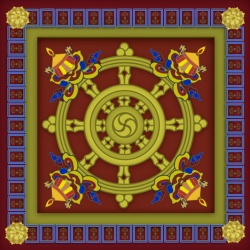Seven precious emblems of royalty
The seven emblems of royalty (Skt. saptaratna; Tib. gyal si na dün; Wyl. rgyal srid sna bdun) are the seven possessions of a universal monarch (Skt. cakravartin). They are:
- the precious golden wheel (Skt. cakraratna; Wyl. 'khor lo rin po che),
- the precious wish-fulfilling jewel (Skt. maṇiratna; Wyl. nor bu rin po che),
- the precious queen (Skt. strīratna; Wyl. btsun mo rin po che),
- the precious minister (Skt. puruṣaratna or pariṇāyakaratna; Wyl. blon po rin po che),
- the precious elephant (Skt. hastiratna; Wyl. glang po rin po che),
- the precious horse (Skt. aśvaratna; Wyl. rta mchog rin po che), and
- the precious general (Skt. khaḍgaratna or senāpatiratna; Wyl. dmag dpon rin po che).
These symbolize the seven noble riches.
In the Thirty-seven Point Mandala Offering, the vase of great treasure is added as an eighth emblem.
Alternative Terms/Translations
- the seven precious gems
- the seven riches of the universal monarch (Chögyam Trungpa)
- the seven jewels of royal power (Dagyab Rinpoche)
The seven riches of the universal monarch: (Seven Richnesses; Archetypes and real riches): "These are very ancient categories first used in India to describe the qualities of a ruler, in this case, for the individual."
Queen: "To have a queen, wife or husband (partner), represents the decency in your household. When you live with someone with whom you can share your life, both your wisdom and your negativities, it encourages you to open up your personality."
Minister: "The principle of minister is having a Councillor, (husband or wife), who promotes your decency. It is said that ministers should be inscrutable."
General: "represents fearlessness and protection; a friend who is fearless. The general is actually a friend who actually cares for you, not one who provides council."
Steed or Horse: "represents industriousness; working hard and exerting your self in sitting (meditation) situations." (ant.: laziness)
Elephant: "Represents steadiness. Though rooted like a tree trunk, you can walk and move forward with steadiness, not swayed by deception or confusion."
The Wish Granting Jewel: Generosity. "Being open hospitable and humorous. The ability to let go and give, not just holding on to these principles."
The Wheel or Iron Wheel: "Represents command over your world. Taking one's seat properly and fully. Allowing all the principles to work together to promote richness and dignity in your life."
Further Reading
- Chögyam Trungpa, Shambhala (Boston & London: Shambhala, 2003 edition), pages 167-169.
- Dagyab Rinpoche, Buddhist Symbols in Tibetan Culture (Boston: Wisdom Publications, 1995), 3. The Seven Jewels of Royal Power.
- Jamgön Kongtrul, Myriad Worlds (Ithaca: Snow Lion, 1995), pages 136-137.
- Robert Beer, The Handbook of Tibetan Buddhist Symbols (Boston: Shambhala, 2003), pages 37-42
Source
RigpaWiki:Seven precious emblems of royalty
